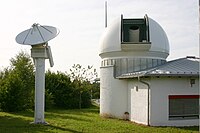
An efficient solution of real-time data processing for multi-GNSS network
Sign Up to like & getrecommendations! Published in 2017 at "Journal of Geodesy"
DOI: 10.1007/s00190-017-1095-x
Abstract: Global navigation satellite systems (GNSS) are acting as an indispensable tool for geodetic research and global monitoring of the Earth, and they have been rapidly developed over the past few years with abundant GNSS networks,… read more here.
Keywords: multi gnss; data processing; real time; gnss ... See more keywords

Multi-GNSS orbit determination using satellite laser ranging
Sign Up to like & getrecommendations! Published in 2018 at "Journal of Geodesy"
DOI: 10.1007/s00190-018-1143-1
Abstract: Galileo, BeiDou, QZSS, and NavIC are emerging global navigation satellite systems (GNSSs) and regional navigation satellite systems all of which are equipped with laser retroreflector arrays for range measurements. This paper summarizes the GNSS-intensive tracking… read more here.
Keywords: orbit determination; multi gnss; laser ranging; day ... See more keywords

Real-time multi-GNSS single-frequency precise point positioning
Sign Up to like & getrecommendations! Published in 2017 at "GPS Solutions"
DOI: 10.1007/s10291-017-0653-2
Abstract: Precise Point Positioning (PPP) is a popular Global Positioning System (GPS) processing strategy, thanks to its high precision without requiring additional GPS infrastructure. Single-Frequency PPP (SF-PPP) takes this one step further by no longer relying… read more here.
Keywords: multi gnss; ppp; gnss; frequency ... See more keywords

Global ionospheric modeling based on multi-GNSS, satellite altimetry, and Formosat-3/COSMIC data
Sign Up to like & getrecommendations! Published in 2018 at "GPS Solutions"
DOI: 10.1007/s10291-018-0770-6
Abstract: Ionosphere total electron content (TEC) from global ionospheric maps (GIM) is widely applied in both ionospheric delay correction and research on space weather monitoring. Global ionospheric modeling based on multisource data is an effective method… read more here.
Keywords: multi gnss; altimetry formosat; modeling based; global ionospheric ... See more keywords

Pivot single-difference ambiguity resolution for multi-GNSS positioning with non-overlapping frequencies
Sign Up to like & getrecommendations! Published in 2019 at "GPS Solutions"
DOI: 10.1007/s10291-019-0891-6
Abstract: Ambiguity resolution in real-time kinematic (RTK) positioning is increasingly dependent on the combination of multi-GNSS observations, especially in challenging signal environments such as urban canyon areas. By applying a priori calibration to the receiver-dependent differential… read more here.
Keywords: multi gnss; overlapping frequencies; ambiguity resolution; ambiguity ... See more keywords

Use of modified carrier-to-code leveling to analyze temperature dependence of multi-GNSS receiver DCB and to retrieve ionospheric TEC
Sign Up to like & getrecommendations! Published in 2019 at "GPS Solutions"
DOI: 10.1007/s10291-019-0895-2
Abstract: Deriving the ionospheric total electron content (TEC) from the global navigation satellite systems (GNSS) measurements typically assumes the receiver differential code biases (RDCBs) to remain unchanged within at least 1 day. However, the RDCBs sometimes… read more here.
Keywords: multi gnss; temperature; code; gnss ... See more keywords

Inter-system and inter-frequency code biases: simultaneous estimation, daily stability and applications in multi-GNSS single-frequency precise point positioning
Sign Up to like & getrecommendations! Published in 2019 at "GPS Solutions"
DOI: 10.1007/s10291-019-0926-z
Abstract: Both inter-system and inter-frequency code biases (ISCB and IFCB) embodied in the multi-GNSS single-frequency precise point positioning (MSFPPP) exhibit mainly as systematic errors. Comprehensive analysis of the ISCB and IFCB characteristics and proper assimilation of… read more here.
Keywords: single frequency; multi gnss; frequency; system inter ... See more keywords

MG-APP: an open-source software for multi-GNSS precise point positioning and application analysis
Sign Up to like & getrecommendations! Published in 2020 at "GPS Solutions"
DOI: 10.1007/s10291-020-00976-1
Abstract: To meet the demands of research and precise point positioning (PPP) in a multi-GNSS environment, we developed a GNSS data processing software named multi-GNSS automatic precise positioning software (MG-APP). MG-APP is an open-source software that… read more here.
Keywords: multi gnss; gnss; precise point; software ... See more keywords

The contribution of Multi-GNSS Experiment (MGEX) to precise point positioning
Sign Up to like & getrecommendations! Published in 2017 at "Advances in Space Research"
DOI: 10.1016/j.asr.2016.05.018
Abstract: Abstract In response to the changing world of GNSS, the International GNSS Service (IGS) has initiated the Multi-GNSS Experiment (MGEX). As part of the MGEX project, initial precise orbit and clock products have been released… read more here.
Keywords: multi gnss; clock; orbit clock; mgex ... See more keywords

PDOP parameters improvement using multi-GNSS and signal re-transmission at lunar distances
Sign Up to like & getrecommendations! Published in 2021 at "Advances in Space Research"
DOI: 10.1016/j.asr.2021.06.040
Abstract: Abstract Precise navigation for satellites of any kind is the key to future cost-effective Lunar missions. The usability of Global Navigation Satellite Systems (GNSS) for such high-altitude applications is still challenging due to reduced signal… read more here.
Keywords: multi gnss; lunar; transmission; parameters improvement ... See more keywords

Evaluation and combination of quad-constellation multi-GNSS multipath reflectometry applied to sea level retrieval
Sign Up to like & getrecommendations! Published in 2019 at "Remote Sensing of Environment"
DOI: 10.1016/j.rse.2019.111229
Abstract: Abstract The satellites of the Global Navigation Satellite System (GNSS) continuously broadcast L-band signals at about a 20-cm wavelength. Some signal-to-noise ratio (SNR) data received by off-shelf geodetic antennas contain the multipath information of the… read more here.
Keywords: multi gnss; sea level; gnss;